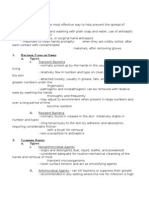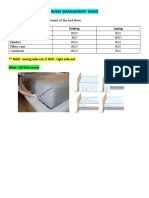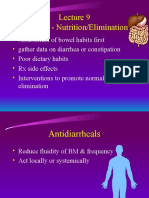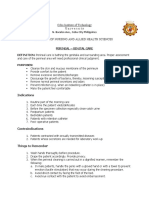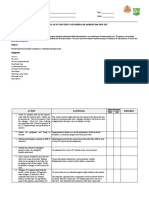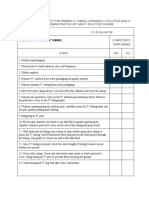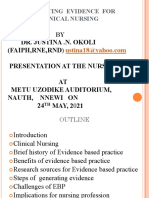Administering Oral Medications
Administering Oral Medications
Uploaded by
Ada Gay Olandia SerencioCopyright:
Available Formats
Administering Oral Medications
Administering Oral Medications
Uploaded by
Ada Gay Olandia SerencioCopyright
Available Formats
Share this document
Did you find this document useful?
Is this content inappropriate?
Copyright:
Available Formats
Administering Oral Medications
Administering Oral Medications
Uploaded by
Ada Gay Olandia SerencioCopyright:
Available Formats
ADMINISTERING ORAL MEDICATIONS
1. Gather equipment. Check each medication order against original physicians order according to agency policy. Clarify any inconsistencies. Check patients chart for allergies. 2. Know actions, special nursing consideration, and adverse effects of medications to be administered. 3. Perform proper hand hygiene. 4. Move medication cart outside patients room or prepare for administration in medication area. 5. Unlock medication cart or drawer. 6. Prepare medications for one patient at a time. 7. Select proper medication from drawer or stock and compare with Kardex or order. Check expiration dates and perform calculations if necessary. a. Place unit dose-package medications in a disposable cup. Do not open wrapper until at bedside. Keep narcotics and medications that require special nursing assessments in a separate container. b. When removing tablets or capsules from a bottle, pour the necessary number into bottle cap and then place tablets in a medications cup. Break only scored tablets, if necessary, to obtain proper dose. c. Hold liquid medication bottles with the label against palm. Use appropriate measuring device when pouring liquids and read the amount of medication at the bottom of the meniscus at eye level. Wipe bottle lip with a paper towel. 8. Recheck each medication package or preparation with the order as it is poured. 9. When all medications for one patient have been prepared, recheck once again with the medication order before taking them to patient. 10. Carefully transport medications to patients bedside. Keep medications in sight at all times. 11. See that patient receives medications at the correct time. 12. Identify the patient carefully. There are three correct ways to do this. a. Check name on patients identification bracelet.
b. Ask patient his or her name. c. Verify patients identification with a staff member who knows patient.
13. Complete necessary assessments before administration of medications. Check allergy bracelet or ask patient about allergies. Explain purpose and action of each medication to patient.
14. Assist patient to an upright or lateral position. 15. Administer medications. a. Offer water or other permitted fluids with pills, capsules, tablets, and some liquid medications.
b. Ask patients preference regarding medications to be taken by hand or in cup and one at a time or all at once. c. If capsule or tablet falls to the floor, discard it and administer a new one.
d. Record and fluid intake I-O measurement is ordered. 16. Remain with patient until each medication is swallowed unless nurse has been patient swallow drug, she or he cannot record drug as having been administered. 17. Perform hand hygiene. 18. Record each medication given on medication chart or record using required format. a. If drug was refused or omitted, record this in appropriate area on medication record.
b. Recording of administration of a narcotic may require additional documentation on a narcotic record stating drug count and other specific information. 19. Check on patient within 30 minutes of drug administration to verify response to medication.
Parenteral medications are drugs given through routes other than the alimentary or respiratory tract.
Indications:
If patient needs fast and immediate drug therapeutic effect If oral or respiratory route is contraindicated If drug effects are optimal and effective in a parenteral route
Routes:
Intradermal into the dermis Subcutaneous into a subcutaneous tissue Intramuscular into a muscle Intravenous into a vein
Less frequently used sites:
Intra-atrial Intracardiac Intraosseous Intrathecal/intraspinal Epidural Intra-articular
Administration: 1. Perform hand washing before anything else 2. Observe the Rights in Administering Medications 3. Check doctors orders
Prepare the medications (check expiration date and physical condition) and equipments Syringe (depends on the injection site and volume of medication to be administered) Needles (appropriate size depending on site/route; withdraw medication from a vial or ampule into a sterile syringe (have separate needles for withdrawal, aspiration and injection) Antiseptic/alcohol swab File Sterile gauze Vials o Vials have powdered medication which needs to be reconstituted, read the intended preparation in the medicine package o There are single dose and multi dose vials, for multi-dose vials, inspect for integrity o Mix the solution (as the package suggests) by rotating the vial between the palms o Remove protective cap or clean the rubber cap and disinfect o Withdraw the medication by initially injecting air equivalent to the volume of medication to be withdrawn, then invert the vial, ensure that the needle tip is below the fluid level and gradually withdraw the medication o Ampules (consists of premixed medications) Flick upper stem of the ampule several times File the neck of the ampule to start a clean break Disinfect and place a sterile gauze around the ampule neck and break off the top bending it towards you Withdraw the medication without touching the rim of the ampule Identify the patient properly and explain the medication to administer (clients knowledge of drug action and response) Locate site of injection (appearance and status), disinfect thereafter Administer medication o Intradermal Injection Explain that a small wheal (bleb) will be produced
Prepare the syringe (hold between thumb and forefinger, hold the needle almost parallel to the skin surface, bevel up) Pull the skin at the site (Common sites: inner lower arm, the upper chest, and the back beneath the scapulae) Insert the tip of the needle until the bevel is in place through the dermis Stabilize the syringe and inject the fluid until it creates a bleb Withdraw the needle, encircle the injection site with ink for observation Subcutaneous Injection Assess site (Common sites: outer aspect of the upper arm, and anterior aspects of the thighs) Prepare the syringe for administration (hold between thumb and finger, with palm facing to the side or upward for a 45 degree angle insertion or with the palm downward for a 90 degree angle insertion) Pinch the skin at site and insert the needle May or may not aspirate before injection, if blood appears, withdraw the needle, continue if otherwise) Inject with a firm steady push, withdraw needle afterwards, wipe the site with gauze Intramuscular Injection Select a site away from large blood vessels, nerves, and bone Pull the skin approximately 2.5 cm to the side Hold the syringe between thumb and forefinger, pierce the skin smoothly and quickly at a 90-degree angle and insert the needle into the muscle Hold the barrel of the syringe steady with non-dominant hand and aspirate (if blood appears, withdraw the needle, continue if otherwise) Withdraw the needle smoothly at the angle of the insertion Apply gentle pressure with gauze Intravenous injection IV Container Locate injection port, remove cover and disinfect Inject the medication in the port Withdraw needle Mix the medication and the solution in rotating motion Label (medication name, solution, date and nurses initial) Spike the bag with the tubing, hang and regulate Existing IV Infusion Determine if the remaining IV solution is sufficient for adding the medication Confirm the desired dilution of the medication Close the infusion clamp Disinfect the medication port, insert the syringe needle and inject the medication Gently rotate the bag or bottle and rehang. Open clamp and regulate Label thereafter IV Push
Check the IV site Locate the medicine port, disinfect with alcohol swab Stop the IV flow by closing the clamp or by simply pinching the tube above the port Connect the syringe to the IV system Aspirate a small amount of blood (checks for patent flow) Inject the medication (comply to the prescribed time of medication administration) After which, remove the syringe needle Discard the uncapped needle, dispose all equipments according to institution practice Wash hands Observe and assess for reactions/response to medication Document all relevant information (time of administration, name of drug, route, clients reaction) Assess effectiveness of the drug at the time it is expected to act
You might also like
- Elderly Bed BathingDocument11 pagesElderly Bed BathingShiann Nicole AranillaNo ratings yet
- Alcohol AbuseDocument2 pagesAlcohol Abusekarl de guzmanNo ratings yet
- Perineal CareDocument9 pagesPerineal CareLalajimNo ratings yet
- Falls Prevention Program Ipsg: Ahmad ThaninDocument12 pagesFalls Prevention Program Ipsg: Ahmad Thaninmanoj reddyNo ratings yet
- Gunshot & Shrapnel WoundsDocument11 pagesGunshot & Shrapnel WoundsAda Gay Olandia Serencio100% (1)
- Behavioral Learning TheoryDocument26 pagesBehavioral Learning TheoryAda Gay Olandia Serencio67% (3)
- DRUGS IN PREGNANCY - A Handbook For Pharmacist and Physician 2021 PDFDocument465 pagesDRUGS IN PREGNANCY - A Handbook For Pharmacist and Physician 2021 PDFadelia100% (1)
- How To Make An Oral Case Presentation To Healthcare ColleaguesDocument5 pagesHow To Make An Oral Case Presentation To Healthcare ColleaguesYuliana Citra AnggraeniNo ratings yet
- ID-IM-SQ-E ToolDocument9 pagesID-IM-SQ-E TooltriciacamilleNo ratings yet
- Bed BathDocument4 pagesBed Bathjavenn mackenzieNo ratings yet
- Checklist Assessing The Neurological System: S.No Steps YES NODocument9 pagesChecklist Assessing The Neurological System: S.No Steps YES NOpramod kumawat100% (1)
- Donning and Removing Personal Protective EquipmentDocument3 pagesDonning and Removing Personal Protective EquipmentJanmae Lee100% (1)
- Annex 4 Donning Removing of Personal Protective Equipments (PPEs)Document2 pagesAnnex 4 Donning Removing of Personal Protective Equipments (PPEs)Khausalya RaniNo ratings yet
- Bed-Making Unoccupied OccupiedDocument7 pagesBed-Making Unoccupied OccupiedAngelyn Españo Ti-adNo ratings yet
- Procedure Checklist Chapter 23: Inserting A Rectal SuppositoryDocument1 pageProcedure Checklist Chapter 23: Inserting A Rectal SuppositoryjthsNo ratings yet
- Bathing A ClientDocument8 pagesBathing A ClientLexie KepnerNo ratings yet
- Assessing The AbdomenDocument18 pagesAssessing The Abdomenmartinezrose32No ratings yet
- Nursing Resource Unit Taking Vital SignsDocument3 pagesNursing Resource Unit Taking Vital Signsdee_day_8No ratings yet
- 2020 Heart and Neck Vessels 2Document66 pages2020 Heart and Neck Vessels 2Faith madayag100% (2)
- Fundic Height Measurement ChecklistDocument2 pagesFundic Height Measurement ChecklistSHENNY ISABELLE ROSALESNo ratings yet
- Procedures FinalDocument102 pagesProcedures FinalChristopher OnteNo ratings yet
- Handwashing - PPEDocument14 pagesHandwashing - PPEdlneisha61100% (2)
- OralMeds - ChecklistDocument6 pagesOralMeds - ChecklistXandra BasnilloNo ratings yet
- Bed BathDocument24 pagesBed BathJemmalyn Fabie0% (1)
- All Demo and ScriptsDocument21 pagesAll Demo and ScriptsKaren CariñoNo ratings yet
- Performance Evaluation Tool Assessing Skin, Hair, and NailsDocument3 pagesPerformance Evaluation Tool Assessing Skin, Hair, and NailsBlessie FernandezNo ratings yet
- Bed Making, The Practical Nursing WayDocument52 pagesBed Making, The Practical Nursing WayGlenda Lagos Loyola100% (7)
- Bed Making Occupied BedDocument4 pagesBed Making Occupied BedVictoriaNo ratings yet
- Sop - Housekeeping1Document4 pagesSop - Housekeeping1DERICK MUDHUNENo ratings yet
- Explanation and Consent: Intravenous CannulationDocument3 pagesExplanation and Consent: Intravenous CannulationAyu IsmaNo ratings yet
- Oleh: Nina Gartika, M.KepDocument41 pagesOleh: Nina Gartika, M.KepAgnisa HayatiNo ratings yet
- NCM 103: Skills Laboratory: LiftingDocument74 pagesNCM 103: Skills Laboratory: LiftingLanzen DragneelNo ratings yet
- Prepared By: Anne Jillian T. Singson, RN, MN: (Assisting Clients in The Use of Assistive Ambulatory Devices)Document22 pagesPrepared By: Anne Jillian T. Singson, RN, MN: (Assisting Clients in The Use of Assistive Ambulatory Devices)Jan Federick Bantay100% (1)
- GRD Performing Nasopharyngeal Nasotracheal SuctioningDocument2 pagesGRD Performing Nasopharyngeal Nasotracheal SuctioningApril Florendo100% (1)
- Telephone Etiquette: A Matter of Using Courtesy and Good MannersDocument4 pagesTelephone Etiquette: A Matter of Using Courtesy and Good MannersCyber MagicNo ratings yet
- Perinal Care FemaleDocument1 pagePerinal Care FemaleRaquel M. MendozaNo ratings yet
- AM CareDocument14 pagesAM CareMila Canoza HerreraNo ratings yet
- Funda Rle Bed MakingDocument4 pagesFunda Rle Bed MakingIvan MaximusNo ratings yet
- Tracheostomy Care ChecklistDocument2 pagesTracheostomy Care Checklistirish felixNo ratings yet
- Module IDocument34 pagesModule INelly CruzNo ratings yet
- 1 Administering Intradermal InjectionDocument3 pages1 Administering Intradermal InjectionKrisyll Meah Torred RamalNo ratings yet
- GI Tract - Nutrition/EliminationDocument51 pagesGI Tract - Nutrition/Eliminationnick_nock08No ratings yet
- Nursing Skills ChecklistDocument6 pagesNursing Skills Checklistapi-433883631No ratings yet
- Nasogastric (NG) Tube Insertion Checklist: Lab Clin Clin Tasks Attempted 1 2 3 4 5 6 7Document5 pagesNasogastric (NG) Tube Insertion Checklist: Lab Clin Clin Tasks Attempted 1 2 3 4 5 6 7Richard PattersonNo ratings yet
- Sterile Field Using Sterile DrapeDocument2 pagesSterile Field Using Sterile DrapekatNo ratings yet
- Bedbath & Perineal CareDocument22 pagesBedbath & Perineal Carealelicheng100% (1)
- Ethico Legal in Health AssessmentDocument74 pagesEthico Legal in Health AssessmentAngelyn Salimbajon100% (1)
- Handwashing MabatidDocument2 pagesHandwashing Mabatidako at ang exoNo ratings yet
- Cleansing Bed Bath: General ObjectivesDocument3 pagesCleansing Bed Bath: General ObjectivesPauline AñesNo ratings yet
- Vital Signs: Jeffrey Evangelista, RN, MANDocument52 pagesVital Signs: Jeffrey Evangelista, RN, MANHikari 光 ShidouNo ratings yet
- Body Mechanics and MobilityDocument24 pagesBody Mechanics and MobilitySori KasasaNo ratings yet
- Cebu Institute of Technology University N. Bacalso Ave., Cebu City Philippines College of Nursing and Allied Health SciencesDocument4 pagesCebu Institute of Technology University N. Bacalso Ave., Cebu City Philippines College of Nursing and Allied Health SciencesMikha BorcesNo ratings yet
- Bed-Occupied BedDocument3 pagesBed-Occupied Bedjerry thomas royNo ratings yet
- CHECKLIST - Administering Oral, Sublingual, and Buccal MedicationDocument4 pagesCHECKLIST - Administering Oral, Sublingual, and Buccal MedicationMichael100% (1)
- Complete Bed Bath RationalesDocument7 pagesComplete Bed Bath RationalesHans TrishaNo ratings yet
- Handwashing ChecklistDocument1 pageHandwashing ChecklistnoriiseaweedsNo ratings yet
- F - e Skills #23 - Changing An IV Solution Container and AdministrationDocument8 pagesF - e Skills #23 - Changing An IV Solution Container and AdministrationJustin AncogNo ratings yet
- BathingDocument34 pagesBathingshannon c. lewis100% (1)
- PROCEDURE CHECKLIST FOR PRIMING IV TUBING AND ETC Revised 1Document3 pagesPROCEDURE CHECKLIST FOR PRIMING IV TUBING AND ETC Revised 1Nicole Sherry M. CHEENo ratings yet
- Name: Josiah Guenn P. Villaraza Group: B Clinical Instructor: Ma'am Irene Cheeries Apal-Enriquez, RN Date: November 7, 2021Document3 pagesName: Josiah Guenn P. Villaraza Group: B Clinical Instructor: Ma'am Irene Cheeries Apal-Enriquez, RN Date: November 7, 2021Princess EduaveNo ratings yet
- Unit 10 Activity & ExerciseDocument110 pagesUnit 10 Activity & ExerciseAshaNo ratings yet
- Perineal Care ChecklistDocument2 pagesPerineal Care ChecklistDaniel Angelo ArangoNo ratings yet
- The politics of hunger: Protest, poverty and policy in England, <i>c.</i> 1750–<i>c.</i> 1840From EverandThe politics of hunger: Protest, poverty and policy in England, <i>c.</i> 1750–<i>c.</i> 1840No ratings yet
- Leaping the Hurdles: The Essential Companion Guide for International Medical Graduates on their Australian JourneyFrom EverandLeaping the Hurdles: The Essential Companion Guide for International Medical Graduates on their Australian JourneyNo ratings yet
- Drug Preparation: (Ampule and Vial)Document25 pagesDrug Preparation: (Ampule and Vial)Ron Lucernas MayugaNo ratings yet
- Serencio AdaGay Requirement3 PDFDocument1 pageSerencio AdaGay Requirement3 PDFAda Gay Olandia SerencioNo ratings yet
- Ra 10575Document2 pagesRa 10575Ada Gay Olandia Serencio100% (8)
- Identification of Person and A Material (Cont.) : Ada Gay O. Serencio, RNDocument28 pagesIdentification of Person and A Material (Cont.) : Ada Gay O. Serencio, RNAda Gay Olandia SerencioNo ratings yet
- Name: - Date: - Anatomy 101 QuizDocument2 pagesName: - Date: - Anatomy 101 QuizAda Gay Olandia SerencioNo ratings yet
- The Chemistry of LifeDocument8 pagesThe Chemistry of LifeAda Gay Olandia Serencio0% (1)
- Newborn Care ChecklistDocument5 pagesNewborn Care ChecklistAda Gay Olandia SerencioNo ratings yet
- 2006 - Psych 101 - General PsychologyDocument7 pages2006 - Psych 101 - General PsychologyAda Gay Olandia SerencioNo ratings yet
- Individual Health RecordDocument1 pageIndividual Health RecordAda Gay Olandia SerencioNo ratings yet
- AnatomyDocument3 pagesAnatomyAda Gay Olandia SerencioNo ratings yet
- Lewis Laryngeal Cancer Case StudyDocument2 pagesLewis Laryngeal Cancer Case Studyatarisgurl08100% (1)
- Lee 2016Document8 pagesLee 2016Pande Agung MahariskiNo ratings yet
- Jeremy Diehl ResumeDocument2 pagesJeremy Diehl Resumeapi-437018433No ratings yet
- Principles of Emergency CareDocument3 pagesPrinciples of Emergency CareNikai Pabayo75% (12)
- Employee EligibilityDocument44 pagesEmployee EligibilityMa Leona Felice MenianoNo ratings yet
- Data Base and History: Semi-Finals: Postpartum WomanDocument7 pagesData Base and History: Semi-Finals: Postpartum WomanJabber PaudacNo ratings yet
- Region 4ADocument11 pagesRegion 4AAlyssa Alexis RamosNo ratings yet
- Niva HDFC Casa Ss v5Document2 pagesNiva HDFC Casa Ss v5skumar779597No ratings yet
- PDEA JOINT AffidavitDocument4 pagesPDEA JOINT AffidavitLorenda Cajigas100% (1)
- HealthCare System of JapanDocument6 pagesHealthCare System of Japanvictor jjumaNo ratings yet
- Basic Life SupportDocument15 pagesBasic Life SupportMizzy Wat EvaNo ratings yet
- Generating Evidence For Clinical Nursing Practice PDFDocument39 pagesGenerating Evidence For Clinical Nursing Practice PDFTamanna VermaNo ratings yet
- Internship Journal 8Document2 pagesInternship Journal 8api-609630655No ratings yet
- Assessment of The Use, Knowledge and Attitude Regarding Hormonal Contraceptives Among Women of Reproductive Age Attending Hoima Regional Referral HospitalDocument11 pagesAssessment of The Use, Knowledge and Attitude Regarding Hormonal Contraceptives Among Women of Reproductive Age Attending Hoima Regional Referral HospitalKIU PUBLICATION AND EXTENSIONNo ratings yet
- UntitledDocument3 pagesUntitledSpace HRNo ratings yet
- Kimporo PackageDocument14 pagesKimporo PackageVincentNo ratings yet
- Transcultural NursingDocument9 pagesTranscultural NursingKish Gabriel GanadoNo ratings yet
- Pines City Colleges: College of NursingDocument7 pagesPines City Colleges: College of NursingMara Jon Ocden CasibenNo ratings yet
- StaffingDocument15 pagesStaffingsalisheyn200910391No ratings yet
- T NG H P Writing Task 1 SampleDocument50 pagesT NG H P Writing Task 1 Samplengân nguyễnNo ratings yet
- Burn NCPDocument4 pagesBurn NCPregNo ratings yet
- Add and Drop 20222023Document3 pagesAdd and Drop 20222023Salahuddeen AbubakarNo ratings yet
- Sri Paripoorna Sanathana Ayurveda Medical College Hospital and Research Centre Medicine ListDocument2 pagesSri Paripoorna Sanathana Ayurveda Medical College Hospital and Research Centre Medicine ListDrNarayan KRNo ratings yet
- Drug Study: Labini, Dienizs Bsn-3EDocument10 pagesDrug Study: Labini, Dienizs Bsn-3EDienizs Labini TadenaNo ratings yet
- Journal For MEdical WardDocument8 pagesJournal For MEdical WardValcrist BalderNo ratings yet
- Presentation 1Document23 pagesPresentation 1Anonymous HK3LyOqR2g100% (1)
- Ma ThèseDocument222 pagesMa ThèseAya Sobhi100% (1)





















